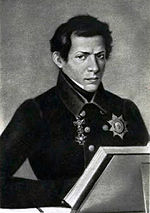Nikolai Ivanovich Lobachevsky
Nikolai Lobachevsky ( Russian Николай Иванович Лобачевский , scientific. Transliteration Nikolai Ivanovich Lobachevski * November 20 jul. / 1. December 1792 greg. In Nizhny Novgorod ; † 12 . Jul / 24. February 1856 greg. In Kazan ) was a Russian mathematician . He was the first to publish a work on non-Euclidean geometry .
Life
Lobatschewski began studying chemistry and pharmacology at the University of Kazan in 1807 , but switched to mathematics , astronomy and physics in 1808 and learned from the German mathematician Johann Christian Martin Bartels (1769-1833), the teacher and later friend of Carl Friedrich Gauß . In 1811 he finished his studies.
He was appointed professor at the Kazan University in 1816, was dean of the physico-mathematical faculty from 1823 to 1824, then director of the university library from 1825 to 1835 and rector from 1827 until his retirement in 1846. In 1837 he was raised to hereditary nobility .
Lobachevsky worked as the deputy curator of the Kazan school district until 1855, when he eventually went blind and died a year after his final retirement. Marija Lvovna Dillon created his monument in Kazan .
plant
Lobachevsky was already working on the parallel axiom of geometry around 1814 , as was the case with the Austro-Hungarian mathematician János Bolyai from around 1820 onwards. Before him, many mathematicians tried to derive Euclid's fifth axiom from the other axioms . Lobachevsky, however, developed a geometry in which the axiom of parallels does not apply, which leads to the non-Euclidean hyperbolic geometry , which is now also called Lobachevsky's geometry . His idea was first reported on February 23, 1826 and printed in the Bulletin of the Kazan University ( Вестник Казанского университета , 1829-1830).
Lobachevski's textbook on higher algebra (1834) mentions other important mathematical achievements in which a method developed independently by Germinal Pierre Dandelin in 1823 and Karl Heinrich Gräffe in 1837 for the approximate determination of the zeros of polynomials of the nth degree (today as the Dandelin-Gräffe method known) and a solution method for homogeneous linear Diophantine equations , rediscovered by Betti in 1862 , was described. Lobatschewski also represented a very modern concept of function and understood a function as an assignment between two sets of real numbers , as Peter Gustav Lejeune Dirichlet did independently a short time later.
The Lobachevskian formulas are named after him.
Honors
As much as his non-scientific work, his pedagogical skills and his organizational commitment earned him high esteem and numerous honors, his scientific work received little recognition during his lifetime. His mathematical thoughts were more like the quirks of an otherwise deserving man. Only Carl Friedrich Gauß paid him tribute and obtained his appointment as a corresponding member of the Göttingen Academy of Sciences in 1842 .
The asteroid (1858) Lobachevskij is named after him.
Trivia
The songwriter Tom Lehrer wrote the song "Lobachevsky" about the name Lobachevsky, which is about scientific plagiarism, but there is probably no reference to the historical person. Tom Lehrer himself says he used this name for onomatopoeic reasons.
Fonts
- Collected works, editor Weniamin Fjodorowitsch Kagan , 4 volumes, Moscow, Leningrad 1946 to 1951 (Russian)
- Two geometric treatises translated from Russian, with annotations and with a biography of the author, by Friedrich Engel, Teubner, 1898, (the treatises On the Beginning of Geometry , Kazaner Bote 1829, New Beginning of Geometry with a Complete Theory of Parallel Lines, Kazaner Scholarly Writings 1835, 1836) Archives
- Panometry, translated and edited by Heinrich Liebmann , Leipzig: W. Engelmann 1902 (Ostwald's classic), archive
- Geometrical researches on the theory of parallels, 1891, La Salle: Open Court 1914 (translator George Bruce Halstead ), Archives , reprinted in Bonola, Non-euclidean geometry, 1912, Dover 1955
- Pangeometry, translator and editor: A. Papadopoulos, Heritage of European Mathematics Series, Volume 4, European Mathematical Society 2010.
literature
- BA Rosenfeld : Lobachevsky, Nikolai Ivanovich . In: Charles Coulston Gillispie (Ed.): Dictionary of Scientific Biography . tape 8 : Jonathan Homer Lane - Pierre Joseph Macquer . Charles Scribner's Sons, New York 1973, p. 428-435 .
- DA Gudkov : NI Lobachevskii, Nizhny Novgorod 1992 (Russian)
- Weniamin Fjodorowitsch Kagan: N. Lobachevsky, Moscow, Leningrad 1948 (Russian, French translation Moscow 1974)
- AV Vasilev: Nikolai Ivanovich Lobachevskii: 1792–1856, Moscow: Nauka 1992 (Russian)
- G. Kasdorf: Lobachevskii, in H. Wussing, W. Arnold, Biographies of important mathematicians, Berlin, 1983
- Alexander Petrowitsch Norden , AP Shirokov: The legacy of NI Lobachevskii and the activity of Kazan geometers, Russian Math. Surveys, Volume 48, 1993, pp. 47-74.
- A. Vucinich: Nicolai Ivanovich Lobachevskii: The Man Behind the First Non-Euclidean Geometry, Isis, Volume 53, 1962, pp. 465-481.
Web links
- Literature by and about Nikolai Iwanowitsch Lobatschewski in the catalog of the German National Library
- John J. O'Connor, Edmund F. Robertson : Nikolai Iwanowitsch Lobatschewski. In: MacTutor History of Mathematics archive .
- Lobatchevski La theorie des paralleles , French
- Lobatschewski Two geometrical studies (German), Pangeometrie (German), Geometrical researches in the theory of parallel lines (English) are available online
Individual evidence
- ↑ As Boris Lukitsch Laptew showed, he attended Bartels' lectures on the history of mathematics based on the textbook by Montucla , in which the axiom of parallels and his attempts at proof are also discussed.
| personal data | |
|---|---|
| SURNAME | Lobachevsky, Nikolai Ivanovich |
| ALTERNATIVE NAMES | Лобачевский, Николай Иванович (Russian spelling) |
| BRIEF DESCRIPTION | Russian mathematician |
| DATE OF BIRTH | December 1, 1792 |
| PLACE OF BIRTH | Nizhny Novgorod |
| DATE OF DEATH | February 24, 1856 |
| Place of death | Kazan |



